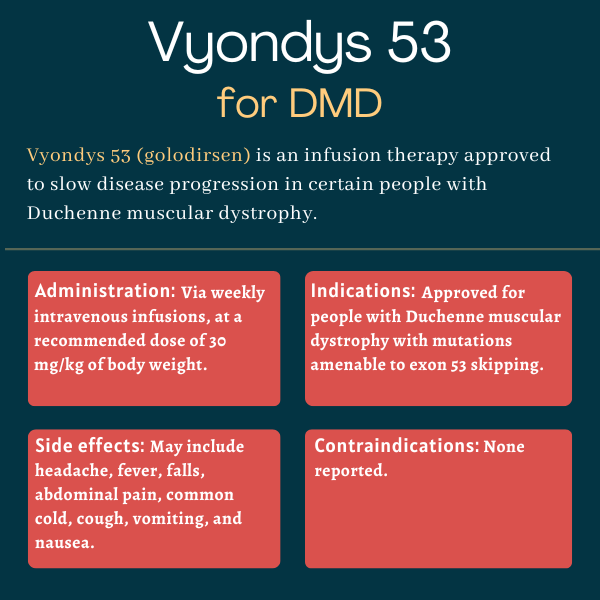Vyondys 53 (golodirsen) for Duchenne muscular dystrophy
Last updated May 15, 2024, by José Lopes, PhD

What is Vyondys 53 for Duchenne muscular dystrophy?
Vyondys 53 (golodirsen) is an exon-skipping therapy conditionally approved in the U.S. to treat people with Duchenne muscular dystrophy (DMD) who carry mutations amenable to exon 53 skipping. It is intended to slow disease progression in eligible patients, which are estimated to make up about 8% of DMD patients.
Developed by Sarepta Therapeutics, the therapy is administered intravenously, or via an infusion into the vein.
Its conditional approval in the U.S. was based on early data that showed it can significantly increase levels of dystrophin, the protein missing in Duchenne. Additional clinical trial results that confirm it can slow or even reverse disease progression will be needed for a full approval.
Therapy snapshot
| Brand name: | Vyondys 53 |
| Chemical name: | Golodirsen |
| Usage: | Used to slow disease progression in DMD patients with mutations amenable to exon 53 skipping |
| Administration: | Intravenous infusion |
How does Vyondys 53 work?
DMD is caused by mutations in the DMD gene, which provides the instructions for making the protein dystrophin that’s important for muscle health. Lack of dystrophin leads to progressive muscle weakness and degeneration.
Like other protein-coding genes, the DMD gene is made of interspersed sections called exons and introns. Exons provide the actual protein-coding parts of the gene, while introns are noncoding regions that are important for regulatory purposes.
When the DMD gene is “read,” the entire gene, with its 79 exons and 78 introns, gets copied into a temporary molecule called messenger RNA. This molecule is then edited to remove the introns and the exons are glued together to form a mature RNA molecule that can be read by the cell’s protein-making machinery.
Certain mutations in DMD can move the genetic code out of alignment, shifting the way the RNA sequence is read to produce a protein. This results in either no protein being produced or in a protein whose sequence is mostly different from the healthy dystrophin protein.
Vyondys 53 is an exon-skipping therapy that binds the abnormal form of the DMD messenger RNA and prompts the cell machinery to exclude exon 53 from the final RNA molecule. Removing this exon enables the remaining exons to fit together, allowing the cell to make a shorter, but still functional version of the dystrophin protein.
Who can use Vyondys 53?
Vyondys 53 was conditionally approved by the U.S. Food and Drug Administration (FDA) in 2019 for treating DMD patients with mutations amenable to exon 53 skipping. This marked the second approval of an exon-skipping therapy, after Sarepta’s Exondys 51.
The approval was made under the accelerated approval pathway, based on early evidence that Vyondys 53 could increase dystrophin levels in eligible patients. A full approval will require confirmation that Vyondys 53 is clinically effective in DMD patients in future trials.
Who should not use Vyondys 53?
The prescribing information for Vyondys 53 lists no contraindications. However, kidney function should be closely monitored during treatment to monitor for kidney toxicity.
How is Vyondys 53 administered?
Vyondys 53 is administered via intravenous infusions, at a recommended dose of 30 mg per kg of body weight. Infusions are given weekly by a healthcare provider, and take between 35 minutes to an hour to complete.
The medication comes in single-dose vials containing 100 mg golodirsen dissolved in 2 mL of a sterile solution — a concentration of 50 mg/mL. The number of vials used in each infusion will depend on the patient’s weight, and will be calculated by a healthcare provider, who will then dilute the appropriate volume of the therapy in a saline solution for infusion.
Prior to the infusion, a topical anesthetic cream may be applied on the skin.
Vyondys 53 should not be mixed with other medications or infused simultaneously with other therapies through the same intravenous access line. In case a dose is missed, the therapy should be administered as soon as possible.

Vyondys 53 in clinical trials
The conditional approval of Vyondys 53 was supported by data from a Phase 1/2 clinical trial (NCT02310906) that demonstrated the treatment’s ability to raise dystrophin levels. The company then launched two Phase 3 trials to further confirm Vyondys 53’s safety and efficacy in DMD patients with mutations amenable to exon 53 skipping.
Phase 1/2 trial
The Phase 1/2 trial, completed in 2019, was a two-part study designed to assess the safety, tolerability, efficacy, and pharmacological properties of Vyondys 53. In the first part, 12 DMD boys received four ascending doses of the therapy — increasing from 4 to 30 mg/kg — or a placebo, given as weekly infusions into the bloodstream for 12 weeks.
The 12 participants and 13 more boys then moved to the second part, wherein all received the 30 mg/kg dose for up to 189 weeks, or about 3.6 years. This part’s main goals were to determine changes in dystrophin levels after 48 weeks as well as changes in the distance participants could walk in six minutes, a measure commonly used to assess physical function in ambulatory patients.
Results showed a significant increase in healthy dystrophin levels after 48 weeks, from less than 0.1% of normal before treatment to just over 1% of normal. The number of dystrophin-positive muscle fibers also increased by more than 13 times over the same period.
Long-term data collected over 144 weeks of treatment showed that walking abilities on the six-minute walking test and lung function declined steadily in participants. But a comparison with an external control group of DMD boys amenable to exon 53 skipping tended to show smaller declines in Vyondys 53-treated patients.
Phase 3 extension study
Sarepta also sponsored a Phase 3 extension study (NCT03532542) that tested the long-term safety and tolerability of Vyondys 53, as well as another exon-skipping therapy called Amondys 45 (casimersen), in DMD patients who’d received these treatments in previous clinical trials.
The study enrolled 171 DMD boys, ages 7 to 23, who received weekly intravenous infusions of either Vyondys 53 or Amondys 45 depending on whether their mutations were amenable to exon 53 or exon 45 skipping.
Results after six years of treatment showed that Vyondys 53 was well tolerated, with side effects being generally mild and unrelated to treatment. No treatment-related discontinuations were reported.
A total of 15 Vyondys 53-treated patients lost the ability to walk, whereas seven could still walk at the study’s completion. Compared to 16 age- and mutation-matched external controls, treated patients saw a median delay in the time to loss of ambulation of about 2.4 years, representing a 47.4% risk reduction.
An additional analysis also suggested Vyondys 53 led to a statistically significant and clinically meaningful lessening in the annual rate of lung function decline compared to the controls.
Ongoing trial
Sarepta is now running a global Phase 3 study called ESSENCE (NCT02500381) to evaluate the effectiveness of Vyondys 53 and Amondys 45 versus a placebo in boys with mutations amenable to exon 53 or exon 45 skipping.
A total of 228 participants have been enrolled and the treatments’ clinical efficacy will be measured with functional tests such as the six-minute walking test, the ability to rise from the floor, loss of ambulation, and changes in lung function. Top-line data is expected by the end of 2025.
Side effects of Vyondys 53
The most common side effects associated with Vyondys 53 in clinical trials include:
- headache
- fever
- falls
- abdominal pain
- common cold
- cough
- vomiting
- nausea.
Allergic reactions
Allergic reactions, such as rash, fever, itchy skin, hives, swelling and irritation of the skin, and skin exfoliation, have been reported in people treated with Vyondys 53. If such a reaction occurs, appropriate medical treatment should be given as needed and Vyondys 53 infusions be slowed or interrupted.
Kidney toxicity
Treatment with golodirsen, the active ingredient of Vyondys 53, has resulted in kidney toxicity in animals. Although this side effect was not observed in clinical trials, other similar medications in have been associated with potentially fatal kidney toxicity.
Thus, kidney function should be monitored via urine and blood testing before starting therapy and routinely while using it. If markers of kidney dysfunction are persistently increased, patients should be referred to a pediatric nephrologist.
Use in pregnancy and breastfeeding
There are no human or animal data on Vyondys 53’s use in pregnancy. It also is not known if the therapy can be found in breast milk and whether it has any impact on breastfed infants or milk production. Patients who are or plan to become pregnant, and those who are nursing or plan to breastfeed, should discuss this topic with their healthcare providers.
Muscular Dystrophy News Today is strictly a news and information website about the disease. It does not provide medical advice, diagnosis, or treatment. This content is not intended to be a substitute for professional medical advice, diagnosis, or treatment. Always seek the advice of your physician or other qualified health provider with any questions you may have regarding a medical condition. Never disregard professional medical advice or delay in seeking it because of something you have read on this website.
Recent Posts
- Myotonic dystrophy drug SRP-1003 trial advances to higher doses
- I’m conflicted about the idea of a cure for muscular dystrophy
- I went from lifting 150 pounds to carrying the weight of Duchenne
- Does DMD start in the womb? New research challenges old beliefs.
- Finding meaning at 30 through my disease communities
Related articles






